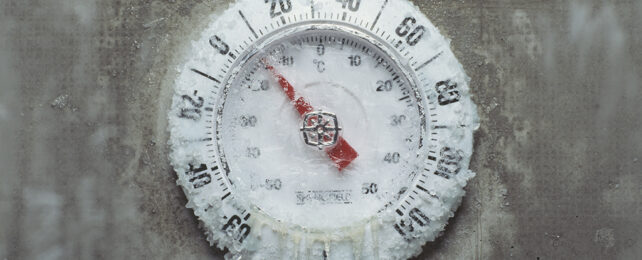The state of perfect stillness known as absolute zero is one of the Universe's impossible achievements. As close as we can get, the laws of physics will always prevent us from hitting thermal rock bottom.
An international team of researchers has now identified a new theoretical route to reach the mythical mark of zero Kelvin, or -273.15 degrees Celsius (-459.67 degrees Fahrenheit). No, it's not more likely to break any laws and remove every last shimmer of heat, but the framework could inspire new ways of exploring matter at low temperatures.
As a consequence of the third law of thermodynamics, the removal of increments of heat energy from a group of particles to cool them to absolute zero will always take an infinite number of steps. As such, it requires an infinite amount of energy to achieve. Quite the challenge.
Classical physics makes this relatively obvious. Viewed in the context of quantum physics, however, the problem begins to look a little different.
Quantum physics describes particles according to a spread of possibilities. Only once a feature is measured does it have a concrete state, and even then, other qualities of the particle become a little less certain. A particle at the theoretical point of absolute zero would have no movement, meaning its position would be certain. Quantum details regarding its prior position would effectively be wiped, deleting information.
Enter Landauer's principle, which states that deleting a piece of information requires a minimum and finite amount of energy.
Does that mean there is a quantum trick to dropping to zero after all?
There are two solutions to the paradox. An infinite amount of time or energy could still be required to make that leap. Or – as per the new research – it would require the deletion of an infinite amount of complexity.
It's this new revelation of the role of complexity that presents a new angle to the search for a pathway to absolute zero, even if it is as practically impossible as a solution as the ones scientists have already been working with.
"We found that quantum systems can be defined that allow the absolute ground state to be reached even at finite energy and in finite time – none of us had expected that," says particle physicist Marcus Huber, from the Vienna University of Technology in Austria.
"But these special quantum systems have another important property: they are infinitely complex."
What we now have is essentially a 'quantum version' of the third law of thermodynamics that goes beyond what classical physics teaches us: an infinite amount of energy, time, or complexity is required to get to absolute zero.
The calculations and modeling carried out by the team also show that the perfect erasure of data and the lowest possible temperature are closely linked, and both apparently impossible to achieve by we mere mortals.
It's possible then that increasing complexity in systems is another way of getting closer to absolute zero, or at least proceeding more quickly.
"If you want to perfectly erase quantum information in a quantum computer, and in the process transfer a qubit to a perfectly pure ground state, then theoretically you would need an infinitely complex quantum computer that can perfectly control an infinite number of particles," says Huber.
In practical terms, no computer system is ever perfect – so the idea that a particle in a quantum computer could never be fully wiped of its data (or previous states) shouldn't be a stumbling block in the development of these technologies.
Quantum mechanics and temperature are closely related – when we get close to absolute zero, strange quantum phenomena start happening – and the researchers say that this is another area where the findings of this study can be useful in the future.
"This is precisely why it is so important to better understand the connection between quantum theory and thermodynamics," says Huber. "There is a lot of interesting progress in this area at the moment. It is slowly becoming possible to see how these two important parts of physics intertwine."
The research has been published in PRX Quantum.
